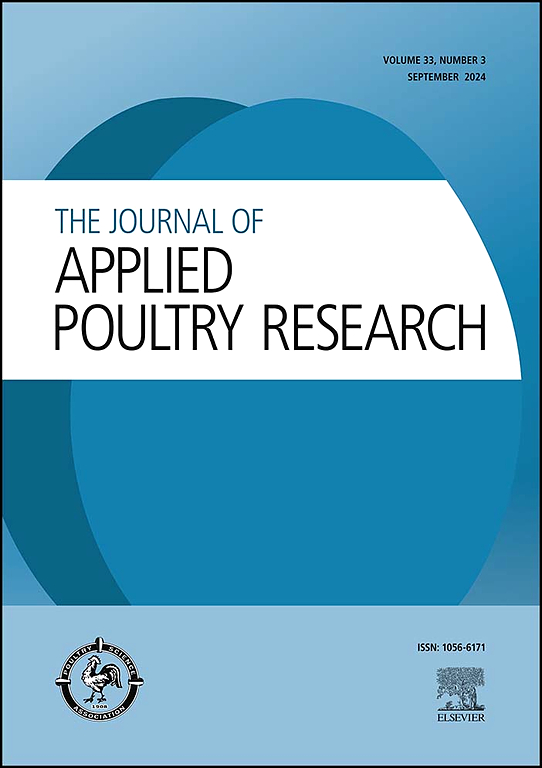Assessment of Eimeria gallopavonis dose for vaccination strategies in turkeys
IF 2
3区 农林科学
Q2 AGRICULTURE, DAIRY & ANIMAL SCIENCE
引用次数: 0
Abstract
Three experiments were conducted to determine the appropriate dose level of E. gallopavonis for autogenous vaccine production to manage its highly virulent nature. In experiment 1, birds were divided into four groups: 0 (Non-inoculated Control, NIC), 30, 90, or 270 E. gallopavonis oocysts per poult (OPB); experiment 2 included NIC, 30, and 90 OPB, while experiment 3 tested NIC, 15, and 30 OPB. Body weight and oocysts per gram of excreta (OPG) were enumerated in experiment 1 on d7 and d14, in experiments 2 and 3 on days 7, 14, 21, and 28. For experiment 1, no differences (p > 0.05) were observed in OPG; BW decreased significantly (p < 0.05) in the 30 and 270 OPB groups, and a 45 % mortality in the 270 OPB group was recorded. In experiment 2, d28, BW in 90 OPB at 776 g was lower (p < 0.05) than NIC birds at 846g. OPG peaked at d14 in pens receiving 30 OPB and those on 90 OPB, but both declined by d28. Lastly, vaccination with 15 OPB in experiment 3 did not affect BW, but 30 OPB levels were lower at d21 and d28 (p < 0.05). OPG levels with those on 30 OPB were significantly higher (p < 0.05) on d21 compared to 15 OPB and NIC. Similarly, mortality was high in the 30 OPB group at 47 %, while the 15 OPB and NIC were 9 % and 7 %, respectively. Among all the dose levels, 15 OPB recorded the lowest adverse effects; however, concern about the consistency of infection at this low dose remains, and thus, additional vaccine management strategies are needed.
对火鸡疫苗接种策略的急速艾美耳虫剂量评估
进行了三项实验,以确定适宜的加洛巴沃那氏肠杆菌剂量水平,用于生产自体疫苗,以控制其高毒性。试验1将雏鸡分为4组:0(未接种对照,NIC)、30、90和270个gallopavonis卵囊/只(OPB);实验2为NIC、30、90 OPB,实验3为NIC、15、30 OPB。试验1在第7天和第14天,试验2和3在第7、14、21和28天分别计算体重和每克排泄物(OPG)卵囊数。对于实验1,没有差异(p >;p < 0.05);体重显著下降(p <;0.05), 270 OPB组死亡率为45%。试验2中,776 g时90 OPB的体重较低(p <;0.05),比NIC的846g大。在OPB为30和90的笔中,OPG最高为14,但都下降了28。最后,在实验3中接种15种OPB对体重没有影响,但在第21天和第28天接种30种OPB水平较低(p <;0.05)。OPG水平在30 OPB组显著升高(p <;与15 OPB和NIC相比,0.05)。同样,30 OPB组的死亡率也很高,为47%,而15 OPB和NIC组分别为9%和7%。在所有剂量水平中,15种OPB的不良反应最低;然而,对这种低剂量感染的一致性的关注仍然存在,因此需要额外的疫苗管理策略。
本文章由计算机程序翻译,如有差异,请以英文原文为准。
求助全文
约1分钟内获得全文
求助全文
来源期刊

Journal of Applied Poultry Research
农林科学-奶制品与动物科学
CiteScore
4.10
自引率
10.50%
发文量
80
审稿时长
104 days
期刊介绍:
The Journal of Applied Poultry Research (JAPR) publishes original research reports, field reports, and reviews on breeding, hatching, health and disease, layer management, meat bird processing and products, meat bird management, microbiology, food safety, nutrition, environment, sanitation, welfare, and economics. As of January 2020, JAPR will become an Open Access journal with no subscription charges, meaning authors who publish here can make their research immediately, permanently, and freely accessible worldwide while retaining copyright to their work. Papers submitted for publication after October 1, 2019 will be published as Open Access papers.
The readers of JAPR are in education, extension, industry, and government, including research, teaching, administration, veterinary medicine, management, production, quality assurance, product development, and technical services. Nutritionists, breeder flock supervisors, production managers, microbiologists, laboratory personnel, food safety and sanitation managers, poultry processing managers, feed manufacturers, and egg producers use JAPR to keep up with current applied poultry research.
 求助内容:
求助内容: 应助结果提醒方式:
应助结果提醒方式:


